Last updated: August 14, 2023
Article
Draw Joshua Tree: Teaching with Museum Collections Lesson Plan
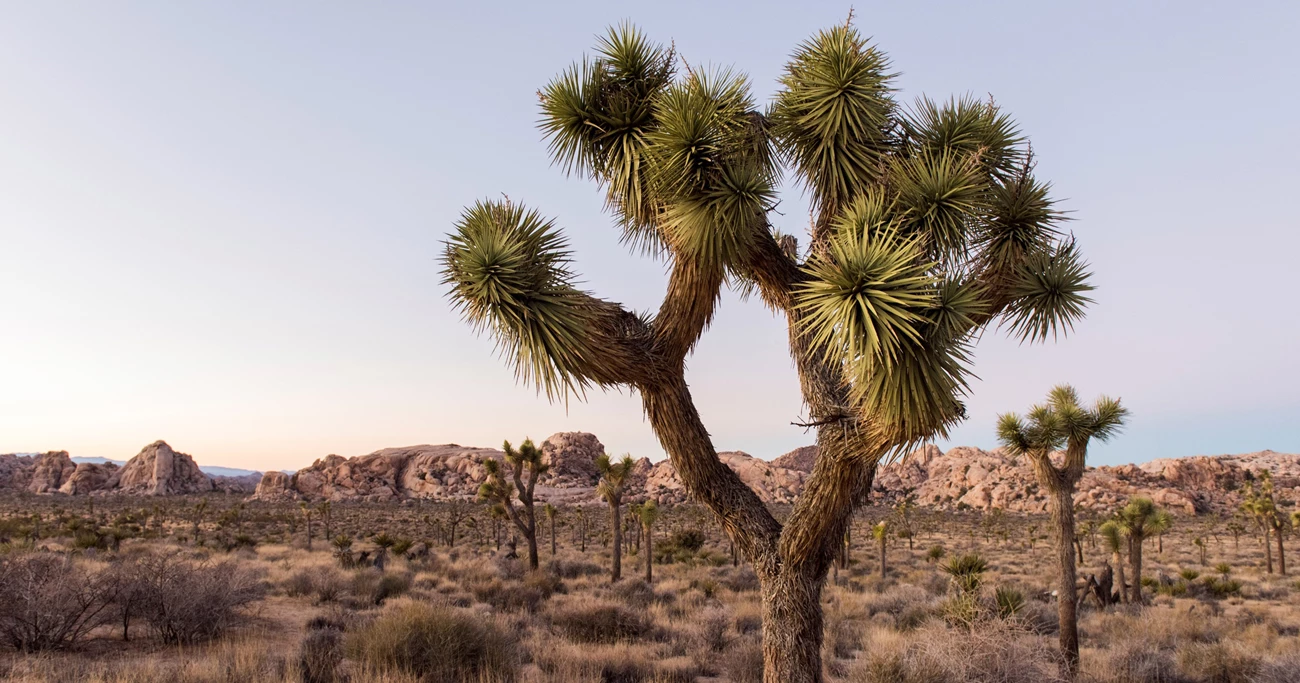
A. Title: Draw Joshua Tree
- Developer: Alison Shoup, Education Specialist, Joshua Tree National Park, Joshua Tree, CA
- Grade Level: 4 (can be modified for different age groups)
- Number of Sessions in the Lesson Unit Plan: One 45-60 minute session
B. Overview
- Park Name: Joshua Tree National Park
- Description: Students will learn about the history of desert conservation and draw a scene of the Mojave Desert within Joshua Tree National Park.
- Essential Question: How do artists create works of art to communicate messages about environmental conservation?
C. Museum Collections and Other Resources Used in this Lesson Plan
-
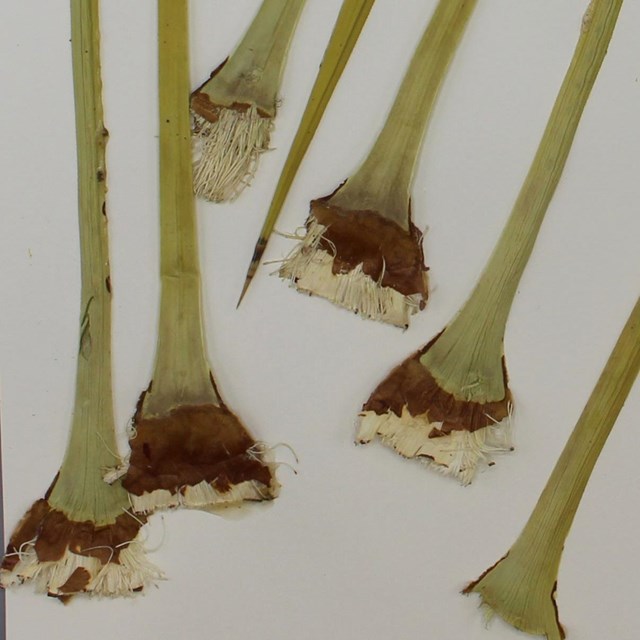 Joshua tree (Yucca brevifolia)
Joshua tree (Yucca brevifolia)Joshua Tree National Park, JOTR 30762
-
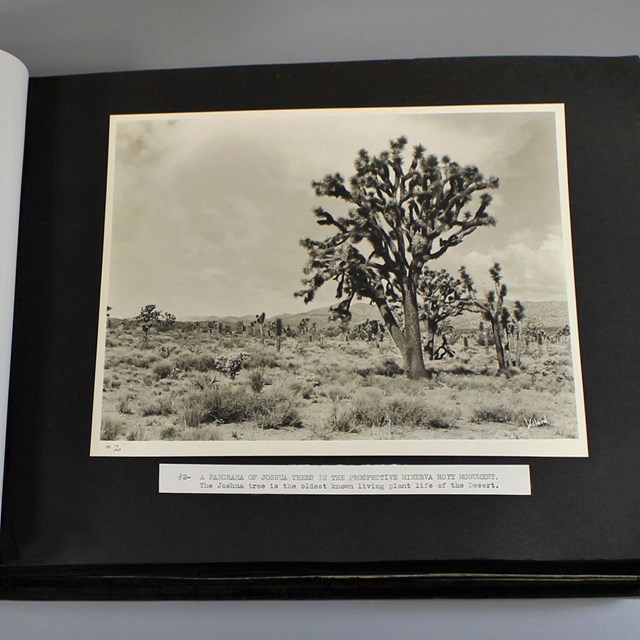 Hoyt Album
Hoyt AlbumJoshua Tree National Park, JOTR 16935
-
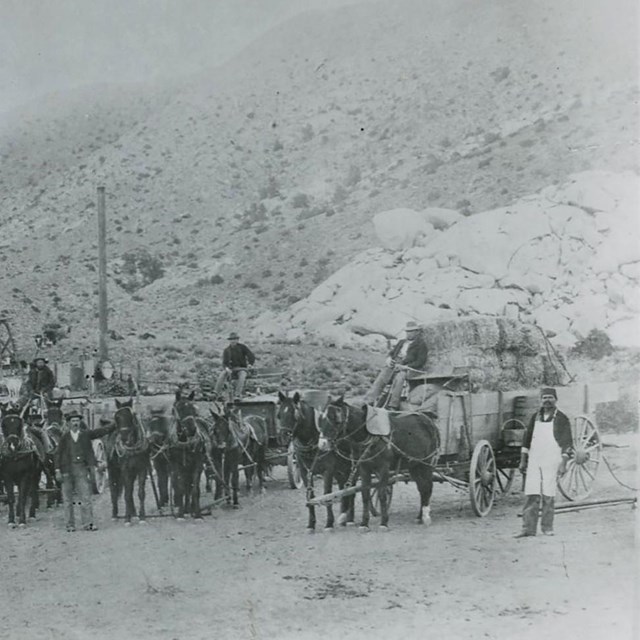 Freight Wagons at Lost Horse Wells
Freight Wagons at Lost Horse WellsJoshua Tree National Park, JOTR 20575, #1618
-
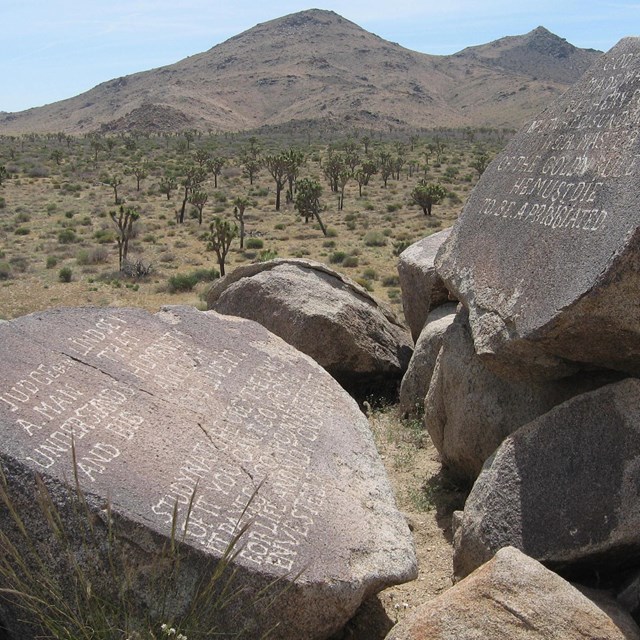 Samuelson’s Rocks
Samuelson’s RocksNational Park Service photograph
-
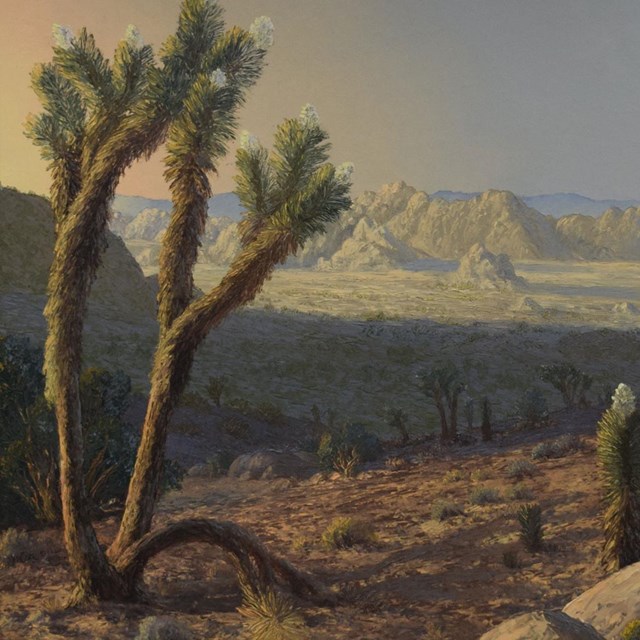 Realm of the Giant Lily John W. Hilton
Realm of the Giant Lily John W. HiltonJoshua Tree National Park, JOTR 450
-
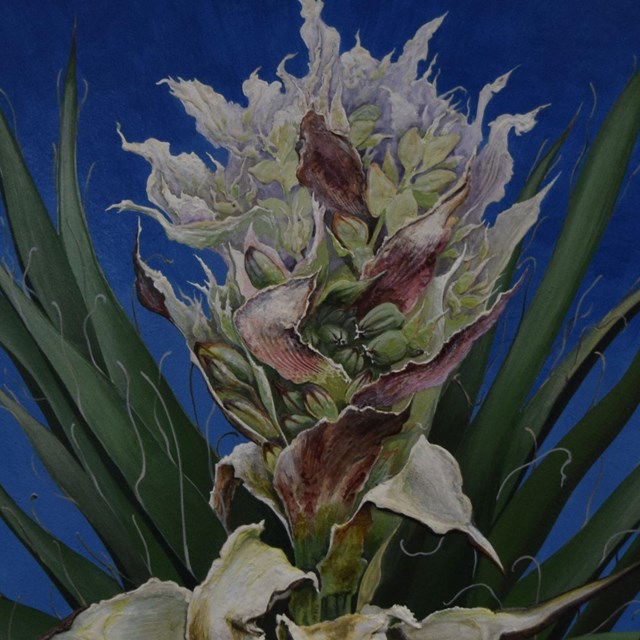 Mojave Yucca
Mojave YuccaJoshua Tree National Park, JOTR 11132
NPS Resources:
- “People of the Desert: Joshua Tree National Park” virtual museum exhibit
- "How to Read an Object”
- “How to Read a Photograph”
- NPS Video “Draw Joshua Tree” directing drawing activity
- Draw Joshua Tree PowerPoint containing photographs of plants and animals found in the drawing video
- Around the Park playlist of eight short videos on park YouTube page. Includes “Landscape and Rock Formations” video showing same view as drawing activity.
- “Granite Desk” Joshua Tree National Park ranger video presentations: “Joshua Trees”, “Camouflage”, “Adaptations”, and “Geology”
- Park Website
- Park online Junior Ranger activities
- “Design your own Adaptable Plant” Junior Ranger Activity
- “Joshua Trees” article on Joshua Tree National Park website
- Live, ranger-led online programming
Drawing activity materials:
- Sharpened colored pencils or crayons: green, brown, yellow, blue, orange, black
- One sheet of 8.5 x 11" white paper
D. National Educational Standards
National Art Standards for Visual Arts https://www.nationalartsstandards.org/
-
4.VA:Cr2.3 Document, describe, and represent regional constructed environments.
Standards for additional grades:
-
PK.VA:Cr2.3 Create and tell about art that communicates a story about a familiar place or object.
-
K.VA:Cr2.3 Create art that represents natural and constructed environments.
-
1.VA:Cr2.3 Identify and classify uses of everyday objects through drawings, diagrams, sculptures, or other visual means.
-
2.VA:Cr2.3 Repurpose found objects to make a new artwork or design.
-
3.VA:Cr2.3 Individually or collaboratively construct representations, diagrams, or maps of places that are part of everyday life.
-
5.VA:Cr2.3 Identify, describe, and visually document places and/or objects of personal significance.
E. Student Learning Objectives
- The student will be able to describe how painting and photography influenced the establishment of national parks.
- The student will be able to identify plants and animal species endemic to the Mojave Desert.
- The student will be able to draw the unique features of plants and animals found in Joshua Tree National Park.
F. Background and Historical Context
During the nineteenth century, artists began to record the beauty and drama of the American West on canvas and in photos. Carleton Watkins, Ansel Adams, Thomas Moran, William Henry Jackson, and others awakened a nation to the magnificent waterfalls, geyser basins, and wildlife found in what would become our national parks. John Muir and Henry David Thoreau touched people the world over with their writing. They looked beyond nature as a raw resource; they spoke in defense of disappearing wildlife and vegetation. They saw beauty and virtue in places promised to the future.
Joshua Tree National Park also owes its existence to the interplay of art and conservation. Minerva Hamilton Hoyt, socialite and master gardener, used photography, writing, and speaking engagements to gain support for preserving the southern California desert. Following the deaths of her son and husband, Hoyt dedicated herself to the cause of protecting desert landscapes. She organized exhibitions of desert plants that were shown in Boston, New York, and London. The exhibitions included elaborately painted backdrops of desert scenery, mounted animal skins, and fresh desert plant specimens flown in daily. She founded the International Deserts Conservation League with the goal of establishing parks to preserve desert landscapes. Hoyt was tapped by noted landscape architect, Frederick Law Olmstead, Jr. to serve on a California state commission formed to recommend proposals for new state parks. She prepared the commission’s report on desert parks and recommended large parks be created at Death Valley, the Anza-Borrego Desert, and in the Joshua tree forests of the Little San Bernardino Mountains north of Palm Springs. On August 10, 1936, President Roosevelt signed a presidential proclamation establishing Joshua Tree National Monument.
Today, artists continue to re-interpret national parks using contemporary approaches and techniques. Musicians, composers, and other performing artists have likewise found inspiration in locations such as Joshua Tree National Park. Their works continue to generate support for the preservation and protection of these irreplaceable habitats.
G. Vocabulary
Species and Terms Used in Lesson:
- Joshua tree
- Yucca moth
- Pup
- Burrow
- Desert tortoise
- Mojave Yucca
- Blacktailed jackrabbit
- Western Diamondback Rattlesnake
- Gambel’s quail
- Mojave
H. Educational Activities
Share images in this lesson plan, and have students take a look at the People of the Desert: Joshua Tree National park virtual museum exhibit.
- Introduction - Introduce Joshua Tree National Park by reviewing each of the museum objects starting with the Joshua tree specimen (JOTR 30762) and the photograph of the Joshua tree in the Hoyt album (JOTR 16935). Have the students use the “How to Read an Object” document to brainstorm why the leaves have this shape, and why the preservation of the Joshua Tree area was so important to preserve.
- Compare and Contrast Activity - Look at the historic photograph Freight Wagons at Lost Horse Wells (JOTR 20575, #1618) then the modern photograph of Samuelson’s rocks. Compare and contrast the two views of the desert landscape using the “How to Read a Photograph” document. Describe how the landscaped has changed. Observe the distant shape of mountains and the patterns of Joshua trees in the landscape and think about how that can all be replicated on paper.
- Drawing Activity (Show NPS directed drawing video or use a document camera and instructions below with NPS Draw Joshua Tree PowerPoint).
- Let’s start with Black
- Find the middle of the paper. We are going to draw a straight line across, just below the middle of the paper. This will be our ground, our sandy surface of the desert.
- Up in the right corner, let’s draw a curve around the corner. We’ll be drawing something in that space later so make it a good size (demonstrate the size).
- Change to Brown
- Place your finger at the middle point of your ground line. Just to the right of that draw two small parallel lines about the width of your finger. Now let’s extend those lines up a little. This is the trunk of our Joshua tree.
- Branches are crazy looking so we’ll draw one branch, then a second that bends upward, and a third that bends downward. Leave them open at the end so we can add the leaves next.
- Change to Green
- Joshua tree leaves are very tough and spiky and they tend to look like balls of spikes at the end of the branch. We are going to draw a ball of spikes on each of the three branches starting with the straight branch. (As you are drawing your leaves, feel free to continue talking about their adaptations e.g. the leaves are thick and waxy to prevent water loss in the harsh desert environment)
- Change to Brown
- When the leaves die, they don’t fall off the tree but instead lay flat against the trunk. Continue to talk about reasons for this (it provides shade for the tree, which keeps it cool and healthy in the desert, this prevents loss of water absorbed through roots into the trunk when it rains or snows) as you fill in the trunk with dead leaves. You’ll probably mention water at some point.
- I mentioned water dripping to the roots, where it gets absorbed and moves into the trunk so let’s draw roots. Compare the width of the roots to the width of the colored pencils/crayons the students are using. As you draw a collection of roots, continue a description of why they are so small and so close to the surface. Add fun facts as you see fit.
- Change to Green
- How do we get new Joshua trees? They can grow from a seed or from the roots of a ‘mother’ tree. Let’s use the green to add a little baby tree or “pup” growing off a root. Then lets go over to the far right side of the paper and add a little tree there. Grab the black and draw a flat little dot under that tree because that tree grew from a seed.
- Where do seeds come from? Flowers! Discuss the flowers of Joshua trees a little and now we’ll draw one in the corner where we blocked off that little space with a black curve. With the green add a few leaves at the bottom.
- Change to Black
- With the black, draw a pyramid-shaped collection of little circles.
- Change to Yellow
- The flowers are an off-white color so let’s very lightly shade the flowers to create that off-white appearance.
- The flowers need to be pollinated to grow seeds so let’s grab Black and draw our little pollinators, the yucca moths, as little, flying V’s. They are the only pollinators that have evolved mouth parts specifically to collect and transfer pollen to other Joshua tree flowers. Write the word Yucca moth above the flower so we remember what the little V’s are.
- Change to Brown
- Let’s draw a cousin of the Joshua tree, the Mojave yucca, over on the left side of the paper. With the brown, draw a skinny, straight brown stalk as tall as your pointer finger. We’ll draw the roots, as well, which are thicker and fewer than the Joshua tree.
- Change to Green
- The leaves are similar to Joshua tree leaves but they are longer and wider so let’s draw longer spiky leaves at the base of the stalk. Sometimes it’s hard to tell a young Joshua tree from a yucca so grab your Black and add little black tips onto the end of your Joshua tree leaves to distinguish them from the yucca.
- Keep that Black and we’ll create a flower bunch at the top of the stalk, similar to what we did with the Joshua tree. You can even shade it a little in with Yellow if you like.
- Optional- if you have time, you can add some little brown fibers coming off the leaves and talk about the uses of the Mohave yucca for Native Americans- fibers could be woven into mats, soles of sandals and rope, roots could be boiled and mashed creating a soapy-like substance, flowers could be eaten, etc.
- Animals- Draw animals to your liking as long as they are easily described for the kids to follow. Draw a jackrabbit and talk about ears and heat reduction, camouflage, etc.; draw a desert tortoise burrow with a tunnel down to its “cave” talking about desert tortoise adaptations (shell, toenails vs. webbed feet, length of burrow can be 3-6ft underground, etc.); consider a bird like a quail with 3 babies (10-12 eggs per clutch, beak is designed for eating seeds); western diamondback rattlesnake with triangular shaped head.
- Landscape - consider adding a boulder pile or mountain in the background just to add a little geology to the drawing.
- FINALLY - pick a color and label the drawing Mojave Desert.
- Set up a gallery show either in class or for families to visit later where students can show off their work.
I. Evaluation/Assessment for Measurable Results
- Assessment should consist of a qualitative analysis based on student work in the past. If they have a proven skill, then did this activity meet their regular level of achievement?
- Do student illustrations resemble the animals and plants?
- Can students verbally describe plant and animal adaptations to the Mojave Desert?
J. Extension and Enrichment Activities
- Create a drawing of your local environment. The drawing should feature 2-3 plants, 3-4 animals, and the landscape features of the local environment.
- Review the image from the Hoyt Album (JOTR 16935) and the feature page on Minerva Hamilton Hoyt in the “People of the Desert: Joshua Tree National Park” virtual museum exhibit. Have students create their own “album” to highlight the natural scenery/animals/etc. in their own community.
- Create a classroom exhibit featuring student’s “album” to show parents or other students/staff.
- Have students write a paragraph lobbying their local government to create a protected site like a national park in a nearby area.
